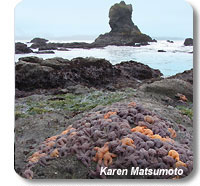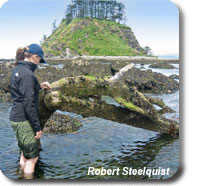In size, the sanctuary covers an area comparable to the following:
- Over one and a half times larger than the entire Puget Sound
- Almost two and a half times larger than Olympic National Park
- The same size as Puerto Rico
- The states of Delaware and Rhode Island combined
See a
map of the sanctuary.
 |
Northern sea otters: a recovery success story unfolding. |
Marine life, ranging from minute ocean drifters called plankton, to humpback whales,
thrive here. Twenty nine species of marine mammals and scores of seabird species spend parts of their
lives here; gray whales visit as part of the longest mammal migration on earth and albatross gather
food here to return to nestlings on mid-Pacific islands and atolls. Sea otters munch on
macro-invertebrates such as urchins, which in turn graze on majestic kelp forests. Fishes occupy
myriad niches from the deepest ocean canyons to the shallowest tide pools.
 |
The high energy shoreline creates diverse communities of intertidal marine life. |
The sanctuary includes
habitats as varied as broad sandy beaches, tide pools, rocky reefs, the open
ocean surface and deep sea canyons. These habitats provide for shelter, feeding, nesting and other
basic needs to sustain diverse and abundant marine wildlife populations.
The Olympic Coast is an example of the temperate Northeast Pacific ocean ecosystem. The
ocean environment is influenced by global patterns
of ocean currents and climate that interact with the
unique geology of the Olympic Mountains, continental shelf and deep sea floor. The sanctuary is
large enough to observe both variety and stability in the ocean processes - important qualities
for studying short- and long-term changes.
 |
The Olympic Coast historical record is preserved in shipwreck remains. |
The human story is important too.
History and culture have left the indelible imprint of people
and their relationship with the ocean. For millennia, Native American cultures have lived and
prospered in a unique bond with the ocean's bountiful resources. And beginning in the 16th century,
European exploration and eventually settlement have left a compelling historical legacy on the
Olympic Coast.



